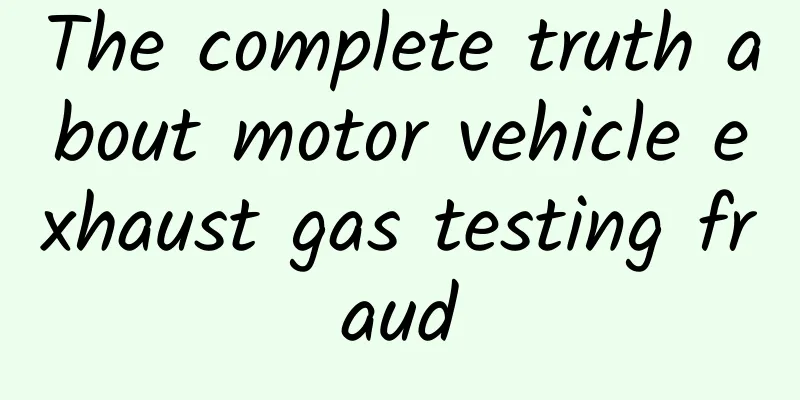The complete truth about motor vehicle exhaust gas testing fraud

|
At this year's National People's Congress, Premier Li Keqiang first mentioned in his government work report that we must resolutely fight the "battle to protect blue skies", which shows the country's determination to control environmental pollution and gives us reason to believe that in the near future we will no longer have to wear masks when going out. Motor vehicle exhaust is one of the main causes of smog weather. Therefore, it is necessary for testing agencies to strengthen motor vehicle exhaust testing to ensure that the exhaust emissions of running vehicles are within the limit. However, motor vehicle exhaust testing fraud is common. Recently, Tianjin Xiqing District Runhua Motor Vehicle Testing Station, Nanjing Qixing Motor Vehicle Testing Co., Ltd., Lianyungang AVIC Motor Vehicle Testing Center, and Lianyungang Dongqi Motor Vehicle Testing Center were all found to have falsified motor vehicle exhaust testing. During the on-site visit of the reporter of China Automotive News, it was found that motor vehicle exhaust testing fraud is not only common, but also has a variety of means of fraud. It can be said that there are policies from above and countermeasures from below. Various methods of testing fraud Location: Beijing. On March 31, the reporter came to Beijing Shenghua Motor Vehicle Inspection Field. In the environmental protection business hall, the reporter met Feng Jun (pseudonym), the person in charge of vehicle management of a Beijing logistics company. He told the reporter that a Dongfeng Xiaokang C37 he bought in 2015 did not pass this year's exhaust gas test. By chance, he met a scalper who was doing motor vehicle exhaust gas testing. After giving the scalper 500 yuan, he successfully passed the test. Feng Jun told the reporter that the scalper drove his car from the South Sixth Ring Road to Shunyi District for testing, drove away in the morning, and returned in the afternoon. Location: Hebei. The reporter met a Jetta owner who came for inspection at a testing site in Langfang, Hebei. The car had traveled about 150,000 kilometers, and the test results showed that it exceeded the standard. The owner found a scalper nearby and gave him 100 yuan. The scalper drove the car over and it passed the inspection smoothly. However, no repairs were made to the vehicle. Location: Nanjing. The reporter took a taxi in Nanjing and asked the driver whether his car could pass the exhaust gas test. The driver said it could not pass, but he could pass it by finding a scalper or giving the inspector 5 packs of cigarettes. The exhaust gas testing fraud has formed an industrial chain, with scalpers playing a connecting role. However, what surprised the reporter even more was that this series of fraud cases was associated with a variety of fraud techniques. The reporter interviewed Ah Hui (pseudonym), a former scalper in Nanjing. He has been involved in this industry for more than ten years and knows the secrets. He told the reporter that exhaust gas testing fraud is divided into vehicle fraud and test line fraud, and there are different fraud methods for diesel and gasoline vehicle testing requirements. The following are nine methods of vehicle fraud that Ah Hui introduced to reporters. The first method is to insert a steel ball coated with a three-way catalyst into the exhaust pipe. The failure or aging of the three-way catalyst is the main reason why most vehicles fail the exhaust gas test. During the test, temporarily replacing the three-way catalyst with a steel ball coated with a three-way catalyst can successfully pass the test, and then take out the steel ball after the test. The second method is to make a hole in the tailpipe and let the exhaust gas of the motor vehicle leak out through the hole. After the hole is made, the concentration of pollutants in the tailpipe will decrease, and the exhaust gas detection probe will not be able to obtain the real emission data, thus ensuring that the motor vehicle that exceeds the standard passes the test. The third method is to inject oxygen into the exhaust pipe. The oxygen mixed with the high-temperature exhaust gas not only reduces the concentration of pollutants in the exhaust pipe, but also oxidizes harmful gases such as carbon monoxide (CO) and nitrogen oxides (NOx) in the exhaust gas, making the vehicle that exceeds the standard pass the inspection. The fourth method is to rent a three-way catalytic converter to replace the unqualified vehicle for inspection, and then return it after inspection. This method has certain limitations. Generally, street repair shops reserve three-way catalytic converters for commonly used models, but there are more than 10,000 models in my country, and it is difficult to find suitable three-way catalytic converters for niche models. The fifth method: In order to make the engine reach the optimal working condition, the spark plug ignition time and fuel injection volume have strict requirements. Counterfeiters can change the ignition time by replacing the spark plugs of unqualified vehicles, replace the fuel injectors to reduce the fuel injection volume, and reduce the exhaust gas discharged from the cylinder to cope with the inspection. This practice will damage the "health" of the engine, and the pollutants in the exhaust gas will increase rapidly in the future operation of the vehicle. The sixth method: Counterfeiters add octane enhancers to unqualified motor vehicles to increase the combustion temperature. Some of the harmful gases such as carbon monoxide (CO) and nitrogen oxides (NOx) in the exhaust gas are oxidized at high temperature, thereby reducing the concentration of pollutants in the exhaust gas. The seventh method: When some unqualified vehicles still have a little oil left, a large amount of ethanol is added to the fuel tank to improve combustion efficiency and change the exhaust composition. The inspection line sets inspection items and parameters for fuel vehicles, so that vehicles that exceed the standard can pass the inspection smoothly. The eighth method: The counterfeiter adjusts the resistance of the engine's electronic control circuit to temporarily change the engine's injection conditions, thereby achieving the purpose of passing the test smoothly. This is an advanced counterfeiting method that is difficult to detect. The ninth method: fake license plate detection is also a fraud method. The counterfeiter installs the license plate of an unqualified vehicle on a qualified vehicle of the same model. The motor vehicle exhaust gas detection does not check the VIN code (vehicle identification number), but only registers the driving license information. Even in the presence of surveillance cameras, unqualified vehicles can pass the inspection. There are also many ways to falsify test lines, of course, this requires the "cooperation" of the testers. The first method: Motor vehicle inspection requires that the exhaust gas detection sampling tube must be inserted 40 cm into the exhaust pipe. Some inspectors fail to insert it properly, and the sampling tube cannot obtain real exhaust gas data, allowing unqualified vehicles to pass. The second method: qualified vehicles and unqualified vehicles are put online for side-by-side testing at the same time, and the exhaust gas detection sampling tubes are cross-inserted, allowing unqualified vehicles to slip through. The third method: Some inspectors install remote control devices on the inspection equipment to control the speed of the inspection equipment, allowing unqualified vehicles to pass the inspection easily. This device is easy to buy online. The fourth method: faking the accelerator pedal. The tester tries to avoid the peak of exhaust emissions by changing the speed of the accelerator pedal, so that the exhaust gas detection sampling tube cannot capture the true situation of vehicle emissions. However, this method is not applicable to vehicles that seriously exceed the standard. The fifth method: flashing computer software. Some inspectors change the parameters of the computer system by flashing software to allow unqualified vehicles to pass. Flashing computer software was a common method used by some inspection lines in the past, but since some inspection lines were exposed for fraud many years ago, this method is rarely used nowadays. Ah Hui told reporters that the above-mentioned fraudulent techniques are common tricks used to falsify motor vehicle exhaust gas testing. In fact, there are far more ways to falsify motor vehicle exhaust gas testing, and people are constantly inventing new methods in "practice." Three-way catalytic converter counterfeiting is rampant Among the various counterfeiting techniques, the one that shocked the reporter the most was the counterfeiting of three-way catalytic converters. The three-way catalytic converter was originally a beneficial attempt promoted by the industry to reduce exhaust emissions from operating vehicles, but speculators used it to falsify vehicle exhaust gas testing, triggering a counterfeiting industry chain. The exhaust gas test of motor vehicles in my country mainly checks the emission of hydrocarbons (HC), carbon monoxide (CO), nitrogen oxides (NOx), particulate matter (PM), etc. It is difficult to meet the requirements of emission regulations by purifying these harmful substances in the engine, and exhaust gas conversion must be carried out by a three-way catalytic converter. In order to cope with the exhaust gas test, some car owners have turned to scalpers for help. Scalpers usually use fake and inferior three-way catalytic converters to help them pass the test. In order to explore the truth about the production of counterfeit three-way catalytic converters, the reporter went to a regular three-way catalytic converter manufacturer to find out more. The person in charge of the company compared the genuine products with the counterfeit products, allowing the reporter to understand the "badness" of the counterfeit three-way catalytic converters. The outer side of the genuine product is made of auxiliary padding material, which not only insulates heat but also prevents the three-way catalytic converter from loosening in the envelope. The outer side of the counterfeit three-way catalytic converter is wrapped with steel mesh, and some exhaust gas is directly discharged from the pipe through the gap of the steel mesh without being filtered by the three-way catalytic converter. In addition, the steel mesh is easy to slide in the envelope, and it is easy to damage the three-way catalytic converter over time. Not only that, the reporter also learned that three-way catalytic converters must use precious metals, which are dissolved in nitric acid and coated on the carrier with other materials. However, a barrel of precious metal solution costs as much as 380,000 yuan. In order to meet the requirements of exhaust gas catalytic conversion, a certain coating thickness must be achieved, which is destined to make the cost of three-way catalytic converters high. In order to reduce costs, counterfeit three-way catalytic converter manufacturers apply as little precious metal as possible. However, if the coating amount is too small, the color will be lighter. In order to solve this problem, counterfeit three-way catalytic converter manufacturers soak their products in soy sauce to try to make the color of the counterfeit three-way catalytic converters similar to the genuine ones. As of September 2016, the number of motor vehicles in China reached 280 million, including 190 million cars. Apart from new cars that are exempt from inspection for six years, the number of vehicles that need to be inspected every year is very large. In such a huge market, even if only a small number of car owners want to cheat, the number of counterfeit three-way catalytic converters used is still very alarming. Where do so many fake and inferior three-way catalytic converters come from? Ah Hui told reporters that about 70% come from Ningjin County, Shandong Province. Ningjin County is located at the junction of Hebei and Shandong in the northwest of Shandong Province. In order to explore the truth about the counterfeiting of three-way catalytic converters, the reporter went to Ningjin County for a field investigation accompanied by an insider named Aliang (pseudonym). The production of counterfeit three-way catalytic converters is hidden in the homes of various farmers. Accompanied by Aliang, the reporter saw the production process of these counterfeit products in small workshops. Aliang told reporters that there are about 200 farmers in Ningjin County producing counterfeit three-way catalytic converters. Production is organized as a family unit, and relatives are stationed outside to sell them. The reporter saw that the yard of the farmer surnamed Li was full of old three-way catalytic converters. On one side of the yard was a simple production workshop with a few simple production tools. The owner surnamed Li pointed to the three-way catalytic converters on the ground and said, this is a Lifan brand, this is a Peugeot brand, and he mentioned nearly 10 brands of three-way catalytic converters. The reporter noticed that the flange thickness of the counterfeit three-way catalytic converter is only 1 mm, which is very different from the 10 mm thickness of the regular product. All the three-way catalytic converter carriers are shorter and smaller. The reporter then went to the office of the owner surnamed Li. The reporter asked the price of a three-way catalytic converter and the other party quoted 38 yuan. This price surprised the reporter. The same product was sold by a regular enterprise to a repair enterprise for 260 yuan, while the price of a fake three-way catalytic converter was not even a fraction of that. The owner surnamed Li also told the reporter that as long as the reporter provided the product size, they could produce any type of three-way catalytic converter. A worker could produce more than a dozen sets of three-way catalytic converters a day, and they could be completed within three days after the order was placed. Payment could be made upon delivery, but it had to be made in cash. In another workshop of a family surnamed Yuan, the reporter noticed that there were more than a dozen brands of three-way catalytic converter production carriers piled up in the room, but the powder color of these carriers was yellow, which was different from the white color of regular manufacturers. In another room, the reporter saw a furnace for baking carriers, which was a simple electric furnace. The technicians of the regular manufacturer told the reporter that the baking of three-way catalytic converter carriers needs to be completed at low temperature, medium temperature and high temperature respectively, and the temperature zones are arranged in sequence from low temperature to high temperature, and the baking furnace is tens of meters long. The carriers produced by the farmer surnamed Yuan complete the three-temperature process in an electric furnace, and the quality of such carriers is worrying. The owner surnamed Yuan told the reporter that they can produce nearly 10 batches of products a day. It doesn't matter if the reporter doesn't want the goods after placing an order, he can sell them quickly at other stores. Where does the problem of exhaust gas fraud lie? "The problem of cheating in exhaust gas testing has a long history. There are four reasons: car owners, testing lines, repair stations, and scalpers. In addition, there is another factor that cannot be ignored, and that is the supervision of the quality inspection department." said Zhang Guodong, secretary-general of the Motor Vehicle Pollution Control Professional Committee of Nanjing Environmental Protection Industry Association. Some vehicles have been in use for more than ten years, but the owners are unable or unwilling to buy new cars, and are unwilling to spend money to repair the three-way catalytic converter. They think that as long as the car can be driven, it is fine. "These car owners know that their vehicles cannot pass the inspection, so they will take the initiative to find scalpers." Zhang Guodong said. In addition, Zhang Guodong introduced that generally speaking, car owners will choose a station nearby for annual inspection. At present, Nanjing has more than 40 inspection lines, and some stations are located in remote areas. Therefore, there are very few vehicles going for inspection. In order to increase business volume, some stations relax the inspection requirements to attract vehicles to go for annual inspection. In 2016, about 680,000 vehicles were tested online in Nanjing, and the first inspection failure rate was about 7%. Zhang Guodong said: "This ratio is very low, not because the environmental protection level of vehicles in Nanjing is high, but because scalpers intercept unqualified vehicles in advance and help them go to the fraudulent inspection station for annual inspection." It is reported that every scalper who has been in this industry for many years has a group of regular customers who will take the initiative to call the car owners in advance to help them with the annual inspection. At the same time, scalpers will also obtain information about new car owners who are about to face annual inspections through various channels. In addition, an underground market has also been formed among scalpers, who introduce each other to car owners who need annual inspections. In order to control the exhaust pollution of motor vehicles, Nanjing City, Jiangsu Province implemented the I/M (inspection/maintenance) system and issued corresponding regulations and implementation rules. The first batch of 17 M stations were determined. Now, the number of M stations exceeds 200. Zhang Guodong said: "The first batch of 17 M stations were strictly evaluated according to the requirements, but the M stations established later were not strictly checked. Some M stations did not meet the standards. After the phenomenon of 'too many monks and too little porridge' appeared, some M stations secretly participated in fraud, and some scalpers registered under the name of M stations and opened maintenance branches outside." "The light punishment for scalpers is an important reason why motor vehicle exhaust fraud is rampant despite repeated bans," said Zhang Guodong. "The Qixing Inspection Station that was exposed not long ago had an annual income of more than 8 million yuan for scalpers, but was fined 50,000 yuan after being exposed. This has no deterrent effect at all." Inadequate supervision has also led to rampant fraud. The quality supervision department conducts annual inspections on motor vehicle inspection lines and requires rectification when problems are found. Zhang Guodong said: "What are the results of the rectification? They have never been made public. Lack of effective supervision is an important reason for fraud in some inspection lines." According to Zhang Guodong, all inspection lines in Nanjing have been in use for more than 8 years. Some equipment is seriously aged and simply replacing parts cannot solve the problem. The fundamental thing is to cut off the idea of car owners to commit fraud "We must use a value-oriented approach to put an end to the falsification of motor vehicle exhaust gas testing. Car owners are the source of the falsification value chain. We must make sure that car owners dare not, do not want to, and are unwilling to falsify data, and the subsequent chain will naturally disappear," said Zhang Guodong. Zhang Guodong believes that there are many ways to cheat on exhaust gas testing, and many people are involved. These middlemen each get a piece of the pie, and it is too difficult to rectify them. There have been many rectifications in the past, but there has never been any fundamental improvement. Only by tackling the source can we cut off the profit chain behind it. Zhang Guodong introduced the specific operation ideas: strengthen the exhaust gas detection of motor vehicles on the road, change the facilities of the detection site from fixed locations to mobile points, and after the inspectors catch an unqualified motor vehicle, they will order it to go to the M station for repair. The owner will go to the exhaust gas detection again with the repair certificate, and then apply to the vehicle management department for exemption from liability after passing the test. If the owner is caught unqualified again in a short period of time, there is reason to fine the owner, and there is also a basis to punish the M station. If the owner is caught unqualified again, he will still be ordered to go to the M station for repair, and will be exempted from liability after passing the test again. Zhang Guodong said: "The cost of repairing a three-way catalytic converter at an M station is about 500 to 600 yuan. If a car owner forges a catalytic converter at a scalper, it will cost about 500 yuan, which is not much cheaper. If a car owner is caught for forging a catalytic converter at a scalper, he will have to spend another 500 yuan to pass the test. Car owners will also do the math. The cost of being caught twice exceeds the cost of repairing at an M station. In addition, they will have to spend more time on the test again, so their luck mentality will be greatly reduced." In addition, according to the current Air Pollution Prevention and Control Law, the environmental protection department does not have the power to punish vehicles that exceed emission standards on the road. There is no penalty code for vehicles with excessive emissions in the vehicle violation penalty system, making it difficult for local public security traffic control departments to punish vehicles that exceed emission standards. An enforcement officer of the Ministry of Environmental Protection said that the above problem must be solved, and having public security traffic control departments impose severe penalties on vehicles that exceed emission standards on the road is an effective way to avoid testing fraud. Li Mengliang, Secretary General of the Motor Vehicle Pollution Prevention Committee of the Environmental Protection Association and Senior Chief Expert of the China Automotive Technology Research Center, is a participant in the formulation of domestic motor vehicle emission standards. He strongly promotes the application of OBD systems in motor vehicle inspections: "The US Environmental Protection Agency (EPA) has made OBD (on-board diagnostic system) inspections an indispensable part of regular inspections of in-use vehicles and has issued corresponding standards. In recent years, the Beijing Municipal Environmental Protection Bureau is formulating local standards for OBD inspections, which are expected to be completed in 2017. By implementing OBD inspections, inspectors can shorten the time of emission inspections and improve the accuracy of inspections, and can accurately locate emission faults, effectively strengthening the supervision of in-use vehicle emission control." The smog alert has been sounded. We hope that relevant departments will take measures as soon as possible to fight the "battle to protect blue skies" and let green mountains, green waters, blue skies and white clouds return to our lives. As a winner of Toutiao's Qingyun Plan and Baijiahao's Bai+ Plan, the 2019 Baidu Digital Author of the Year, the Baijiahao's Most Popular Author in the Technology Field, the 2019 Sogou Technology and Culture Author, and the 2021 Baijiahao Quarterly Influential Creator, he has won many awards, including the 2013 Sohu Best Industry Media Person, the 2015 China New Media Entrepreneurship Competition Beijing Third Place, the 2015 Guangmang Experience Award, the 2015 China New Media Entrepreneurship Competition Finals Third Place, and the 2018 Baidu Dynamic Annual Powerful Celebrity. |
<<: Korean cars are in decline, THAAD can't take the blame
>>: Can Apple’s wake-up call for Qualcomm’s industry monopoly continue?
Recommend
my country's first! The "Noah's Ark" of the seed industry is here
On October 20, China's first provincial compr...
Double No. 1! Perfect ending! This time we really have to say goodbye...
Screenshot from the Beijing Winter Paralympic Gam...
Pay attention! Should you drink a cup of coffee in the morning or in the afternoon?
A cup of coffee a day seems to be the standard fo...
Introduction to 360 Mobile Search CPC Advertising Promotion!
360 Mobile Search Promotion...
Why are Antarctic fish not afraid of freezing? | Science Museum
Antarctica is the coldest place on Earth, and the...
iPhone 6 locked remotely: Don't use it if you don't pay
I just bought an iPhone 6, but it was suddenly lo...
From The Mandalorian to iQiyi’s The Bad Well, virtual production is integrated into the film and television industry
Recently, many LED manufacturers have announced t...
IBM: State of Salesforce report
IBM has released a new report, "The State of...
Analysis report on second-hand e-commerce Duozhaoyu!
With the development of the second-hand e-commerc...
The Lancet sub-journal: 5 good habits that can help Chinese people live longer
If you are in your early twenties now, have you e...
Dialogue with Academician Zhu Min, searching for the human ancestor 440 million years ago
Are humans' ancestors fish? Chinese Academy o...
Ruthless Nokia: Employee was fired for absenteeism after attending funeral
Mr. Wan, an employee of Nokia Communication Syste...
The Quotes of Steve Jobs You Haven't Heard of - Another Steve Jobs
[[125806]] Deciding what not to do is just as imp...
Is the effect of bidding advertising promotion terrible? Pay attention to these 4 points
I often hear advertisers complain that SEM promot...
Google spent $1.1 billion to buy the Pixel team from HTC. Do you remember MOTO 6 years ago?
Today, Google and HTC reached a $1.1 billion part...









